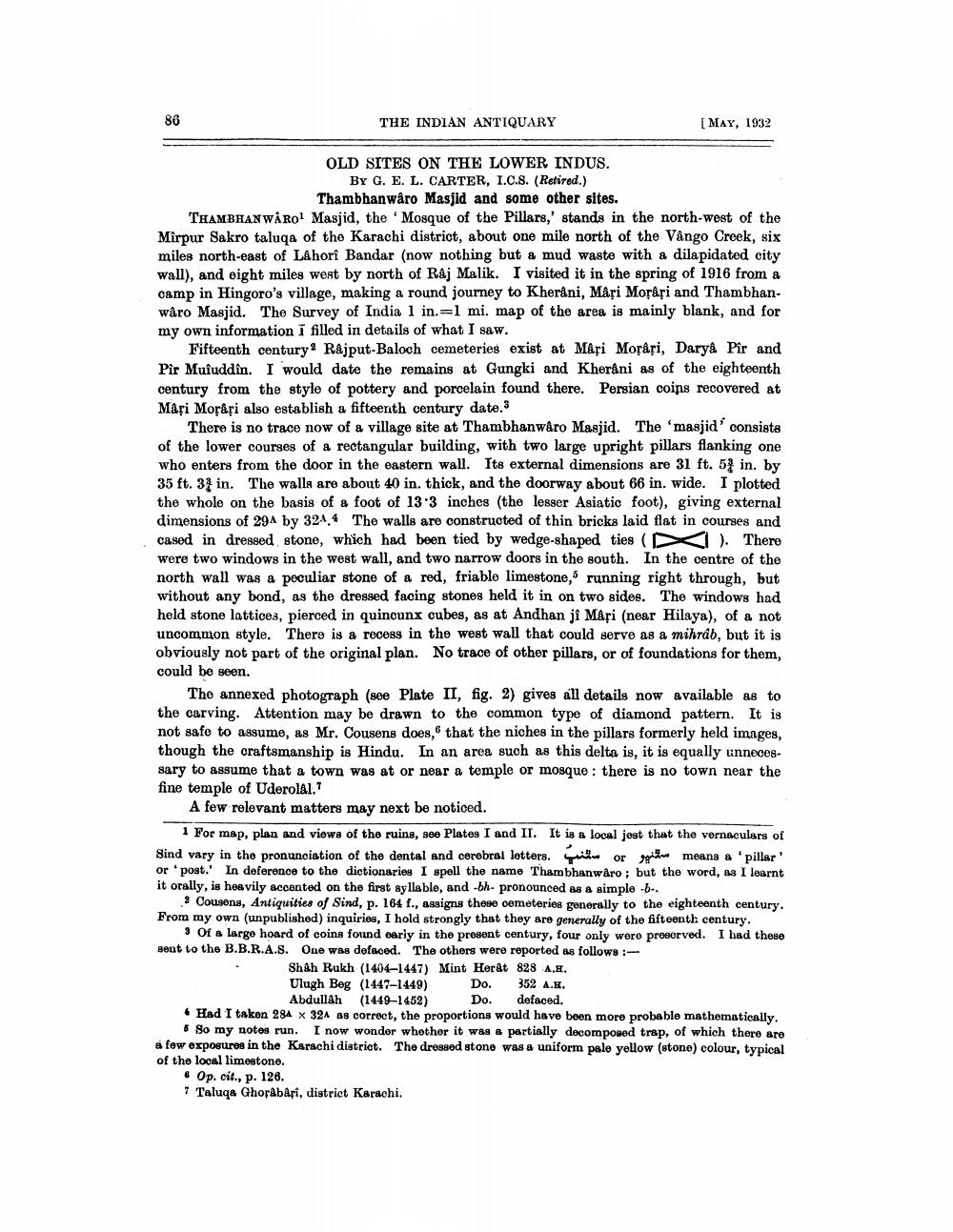________________
36
THE INDIAN ANTIQUARY
[MAY, 1932
OLD SITES ON THE LOWER INDUS.
BY G. E. L. CARTER, I.C.S. (Retired.)
Thambhanwaro Masjid and some other sites. THAMBHANWA RO? Masjid, the 'Mosque of the Pillars,' stands in the north-west of the Mirpur Sakro taluqa of the Karachi district, about one mile north of the Vângo Creek, six miles north-east of Lahori Bandar (now nothing but a mud waste with a dilapidated city wall), and eight miles west by north of Raj Malik. I visited it in the spring of 1916 from a camp in Hingoro's village, making a round journey to Kherani, Mâți Morâți and Thambhanwâro Masjid. The Survey of India 1 in.=l mi. map of the area is mainly blank, and for my own information i filled in details of what I saw.
Fifteenth century Rajput-Baloch cemeteries exist at Mari Moråri, Darya Pir and Pir Musuddin. I would date the remains at Gungki and Kherani as of the eighteenth century from the style of pottery and porcelain found there. Persian coins recovered at Mari Morâri also establish a fifteenth century date.3
There is no trace now of a village site at Thambhanwaro Masjid. The 'masjid' consists of the lower courses of a rectangular building, with two large upright pillars flanking one who enters from the door in the eastern wall. Its external dimensions are 31 ft. 54 in. by 35 ft. 34 in. The walls are about 40 in. thick, and the doorway about 66 in. wide. I plotted the whole on the basis of a foot of 13.3 inches (the lesser Asiatic foot), giving external dimensions of 29A by 324.4 The walls are constructed of thin bricks laid flat in courses and cased in dressed stone, which had been tied by wedge-shaped ties (
). There were two windows in the west wall, and two narrow doors in the south. In the centre of the north wall was a peculiar stone of a red, friable limestone, running right through, but without any bond, as the dressed facing stones held it in on two sides. The windows had held stone lattices, pierced in quincunx cubes, as at Andhan ji Mari (near Hilaya), of a not uncommon style. There is a recess in the west wall that could serve as a mihrab, but it is obviously not part of the original plan. No trace of other pillars, or of foundations for them, could be seen.
The annexed photograph (see Plate II, fig. 2) gives all details now available as to the carving. Attention may be drawn to the common type of diamond pattern. It is not safe to assume, as Mr. Cousens does, that the niches in the pillars formerly held images, though the craftsmanship is Hindu. In an area such as this delta is, it is equally unnecessary to assume that a town was at or near a temple or mosque: there is no town near the fine temple of Uderol41.7
A few relevant matters may next be noticed.
1 For map, plan and views of the ruins, see Plates I and II. It is a local jest that the vernaculars of Sind vary in the pronunciation of the dental and cerebral lotters. Wh or e means a 'pillar' or post.' In deference to the dictionaries I spell the name Thambhanwaro; but the word, as I learnt it orally, is heavily accented on the first syllable, and -bh- pronounced as a simple -b..
2 Cousons, Antiquities of Sind, p. 164 f., assigns these oemeteries generally to the eighteenth century. From my own (unpublished) inquiries, I hold strongly that they are generally of the fifteenth century.
3 Of a large hoard of coins found early in the present century, four only wore prosorved. I had these sent to the B.B.R.A.S. One was dofaced. The others were reported as follows:
Shah Rukh (1404-1447) Mint Herat 828 A.H. Ulugh Beg (1447–1449) Do. 352 A.E.
Abdullah (1449-1452) Do. defaced. • Had I taken 284 x 32A as correct, the proportions would have been more probable mathematically.
6 So my notes run. I now wonder whether it was & partially decomposed trap, of which there are a few exposures in the Karachi district. The dressed stone was a uniform palo yellow (stone) colour, typical of the local limestone.
• Op. cit., p. 126. 7 Taluqa Ghor&bari, district Karachi.




